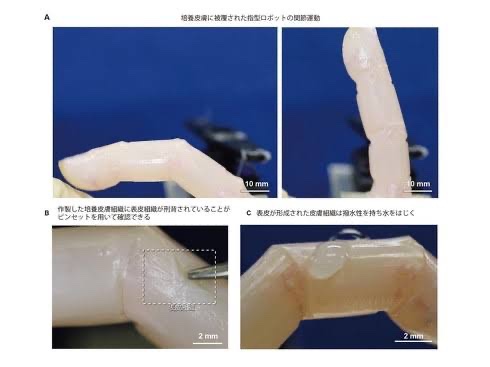
The University of Tokyo: Finger-shaped robot with skin:
-Self-repair by cell proliferation even if damaged-
University of Tokyo
Professor Shoji Takeuchi
The research group
We have developed a finger-type robot covered with cultured skin derived from human skin cells.
Finger-type robots self-repair by cell proliferation even if they are injured.
Conventional challenges:
Until now, the surface of robots is “often covered with silicone rubber.”
When it is damaged, it cannot be restored, and there is a “problem such as difficulty in releasing heat inside”.
Applied to artificial hands and cultured leather:
The technology developed this time can be applied to artificial hands and cultured leather.
Reproduce nerves and blood vessels:
Currently, nerves and blood vessels are not reproduced.
By adding functions, we will develop biological functions such as sensing.
Nihon Keizai Shimbun
https://www.nikkei.com/article/DGXZQOUC0964X0Z00C22A6000000/
L’Université de Tokyo : Robot en forme de doigt avec peau :
-Auto-réparation par prolifération cellulaire même endommagée-
Université de Tokyo
Professeur Shoji Takeuchi
Le groupe de recherche
Nous avons développé un robot de type doigt recouvert de peau cultivée dérivée de cellules de peau humaine.
Les robots de type doigt s’auto-réparent par prolifération cellulaire même s’ils sont blessés.
Défis classiques :
Jusqu’à présent, la surface des robots est “souvent recouverte de caoutchouc de silicone”.
Lorsqu’il est endommagé, il ne peut pas être restauré et il y a un “problème tel que la difficulté à dégager de la chaleur à l’intérieur”.
Appliqué aux mains artificielles et au cuir cultivé :
La technologie développée cette fois peut être appliquée aux mains artificielles et au cuir cultivé.
Reproduire les nerfs et les vaisseaux sanguins :
Actuellement, les nerfs et les vaisseaux sanguins ne sont pas reproduits.
En ajoutant des fonctions, nous développerons des fonctions biologiques telles que la détection.
Nihon Keizai Shimbun
Die Universität Tokio: Fingerförmiger Roboter mit Haut:
-Selbstreparatur durch Zellproliferation auch bei Beschädigung-
Universität Tokio
Professor Shoji Takeuchi
Die Forschungsgruppe
Wir haben einen fingerartigen Roboter entwickelt, der mit gezüchteter Haut aus menschlichen Hautzellen bedeckt ist.
Roboter vom Fingertyp reparieren sich selbst durch Zellproliferation, selbst wenn sie verletzt sind.
Konventionelle Herausforderungen:
Bisher sei die Oberfläche von Robotern „häufig mit Silikonkautschuk überzogen“.
Wenn es beschädigt ist, kann es nicht wiederhergestellt werden, und es gibt ein “Problem wie Schwierigkeiten bei der Wärmeabgabe im Inneren”.
Angewandt auf künstliche Hände und kultiviertes Leder:
Die damals entwickelte Technologie kann auf künstliche Hände und kultiviertes Leder angewendet werden.
Nerven und Blutgefäße reproduzieren:
Derzeit werden Nerven und Blutgefäße nicht reproduziert.
Durch das Hinzufügen von Funktionen werden wir biologische Funktionen wie die Wahrnehmung entwickeln.
Nihon Keizai Shimbun
Living skin on a robot Highlights
– ScienceDirect
• The method for generating seamless coverage of 3D objects with skin equivalent
• Three-joint robotic finger covered with living skin equivalent
• Wound repair of a robotic finger covered with dermis equivalent
https://www.sciencedirect.com/science/article/pii/S2590238522002399